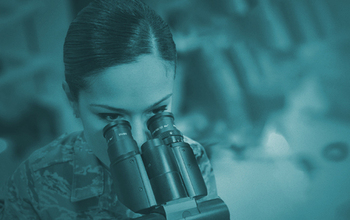News Release 18-033
USAF and NSF announce partnership in science and engineering research
Agreement will create pathways for collaboration in areas of common interest
May 9, 2018
This material is available primarily for archival purposes. Telephone numbers or other contact information may be out of date; please see current contact information at media contacts.
Air Force Secretary Heather Wilson and National Science Foundation (NSF) Director France Córdova signed a Letter of Intent May 9, 2018, creating a new partnership for collaboration on scientific and engineering research to bolster national security.
The Letter of Intent initiates a strategic partnership focused on research in four areas of common interest: space operations and geosciences, advanced material sciences, information and data sciences, and workforce and processes.
"We are looking forward to deepening our ties with the National Science Foundation," Wilson said. "We will simultaneously benefit from the research done together with a focus on the areas most vital to the future of the U.S. Air Force and the security of our Nation."
The partnership is designed to create a pathway between the basic research supported by NSF and the technologies needed to support the Air Force of tomorrow. Common areas of interest will drive cooperation at every level of research, including basic research, applied research and advanced technology development.
"Ensuring national security through innovation in science and engineering was part of the National Science Foundation's founding mission nearly seven decades ago, and it remains one of our highest priorities today," Córdova said. "We look forward to partnering with the Air Force on this collaborative venture and using our combined resources to innovate for the benefit of the nation."
This partnership reflects White House priorities including strong national security and efficient government operations.
"Rebuilding America's defense capabilities has been a top priority of the Trump Administration since inauguration. A big part of that is translating fundamental discoveries into breakthroughs that make the country safer and drive the U.S. economy," said Michael Kratsios, deputy assistant to the President for technology policy at the White House Office of Science and Technology Policy. "This partnership between two of America's R&D powerhouses -- the Air Force and the National Science Foundation -- will ensure that taxpayer funding of basic research is made more efficient, accelerates the development of advanced technologies for both civilian and military use, and fosters job creation and economic growth into the future."
The letter states that "The Air Force will benefit from greater access to NSF's considerably larger basic research program and community of researchers. The NSF will benefit with a direct pathway for the technical maturation of many of its research efforts and products, with increased relevance afforded by its direct support of the Nation's defense posture."
In anticipation of the signing, the two organizations have already had initial discussions on topics ranging from the convergence of artificial intelligence, data and materials, to placements for fellows from NSF's Graduate Research Intern Program.
The letter is available online.
-NSF-
Media Contacts
Rob Margetta, NSF, (703) 292-2663, email: rmargett@nsf.gov
Laura Mcandrews, U.S. Air Force, email: laura.m.mcandrews.civ@mail.mil
Related Websites
Letter of Intent between the Department of the Air Force and the National Science Foundation Concerning a Partnership to Coordinate Mutual Research Interests: https://www.nsf.gov/news/newsmedia/USAF-NSF_Mutual_Letter_of_Intent.pdf
The U.S. National Science Foundation propels the nation forward by advancing fundamental research in all fields of science and engineering. NSF supports research and people by providing facilities, instruments and funding to support their ingenuity and sustain the U.S. as a global leader in research and innovation. With a fiscal year 2023 budget of $9.5 billion, NSF funds reach all 50 states through grants to nearly 2,000 colleges, universities and institutions. Each year, NSF receives more than 40,000 competitive proposals and makes about 11,000 new awards. Those awards include support for cooperative research with industry, Arctic and Antarctic research and operations, and U.S. participation in international scientific efforts.
Connect with us online
NSF website: nsf.gov
NSF News: nsf.gov/news
For News Media: nsf.gov/news/newsroom
Statistics: nsf.gov/statistics/
Awards database: nsf.gov/awardsearch/
Follow us on social
Twitter: twitter.com/NSF
Facebook: facebook.com/US.NSF
Instagram: instagram.com/nsfgov

